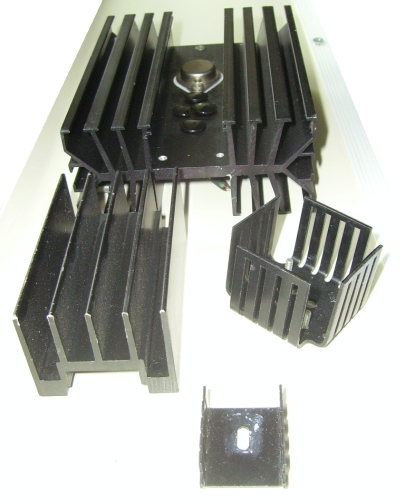
- Conduction:
- Use a good conductor of heat. This will be metal.
- Aluminium or more rarely copper is used.
- Convection:
- To maximise convection, have a large surface area often with fins.
- Radiation:
- Matte black colouration to maximises heat radiation.
- A large surface area also helps with heat radiation.
- Good thermal contact:
- Use silicone grease or another thermal contact compound.
- This improves the heat flow from the component into the heatsink.
- Large thermal capacity:
- Heatsinks are heavy.
- This allows the heatsink to soak up sudden short bursts of heat.
- Forced convection:
- Heatsinks can be fan assisted (Computer processor cooling).
- For serious heavy duty applications like industrial power switching, large motor control or high power radio transmitting they can be water or oil cooled.
- Heatsinks are often manufactured as part of the equipment case.
AQA Exam Answer
For good marks, be sure to use the words, conduction, convection and radiation in your exam answer. For each word explain how the heatsink works.
Heat Sink Ratings or Thermal Resistance
The heatsink thermal resistance number tells you how much the heatsink temperature will rise when one watt of heat is dissipated. Bigger heatsinks get rid of waste heat more easily so their temperature rises less so lower numbers indicate more effective heatsinks.
- Heatsinks are rated in Degrees per Watt.
- Rearranging the Formulas ...
- Temperature_Rise = Power_Dissipated x Thermal_Resistance
- Power_Dissipated = Temperature_Rise / Thermal_Resistance
- Thermal_Resistance = Temperature_Rise / Power_Dissipated
- Temperature_Rise = Power_Dissipated x Thermal_Resistance
Power_Dissipated = Volts x Amps
P = V I
